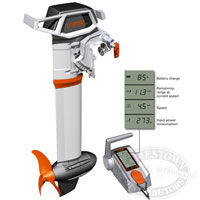At IBEX last September I noticed that there were more electric outboard vendors. I especially talked to the Torqueedo guys as I had used those on the oceanography drone catamarans I designed a year ago. http://multihullblog.com/2015/02/oceanography-drone-on-youtube/
They told me that Google had been using their units to do coastal mapping now. I decided to look that up. Meanwhile I also found
Parsun www.parsun.biz and www.parsun.co.cn Chinese outboards, including electric units. And
Elco www.elcomotoryachts.com And don’t forget the Torquedo units. www.torqueedo.com

I bumped into http://oceanvolt.com/ recently to add to the list. It seems that some, but not all of these are able to generate power, which seems like it would be a nice feature.
Dan – I’m not sure I understand your very small vs. very large comment. Why do you say that? Batteries scale basically linearly.. add more cells, add more capacity.. and add more weight. Ditto for solar panels. And electric motors themselves are available in all sizes.
I’m sure there is a bit of a step function involved if you want or need to throw a generator in the mix for a real gas/diesel hybrid system. In that case, gas/diesel generators are only available down to certain minimum sizes/weights, and efficiency tends to go up with size. So “somewhere larger than a kayak” where you’d consider adding a small generator, there would be some boats where you should really just skip the batteries + electric motor and just use a gas outboard instead.
The big, overall disadvantage to electric for multis is that unlike gas/diesel, batteries don’t get lighter when you use the power out of them! So when weight matters a lot, they aren’t quite as competitive.
But I would be relatively interested to see how the equations balance out for hybrid systems in boats (vs. cars). The huge differentiator IMHO, is that you CAN in a boat effectively convert wind power (from your sails) into stored electricity by dragging the electric motor/generator prop – comparable to regenerative braking, but not exactly, since you can presumably set it so it just costs you a few knots, rather than bringing you to a stop. And unlike a car, you can reasonably add a bunch of solar panels into the mix (without even much weight penalty!). I imagine if one looks at the curves, there is some sweet spot for any given boat between:
* number of batteries
* battery efficiency (which is slowly, but steadily improving)
* square feet of solar panel
* solar panel efficiency (slowly but steadily improving)
* regeneration from prop dragging
* weight/size of all of the above, vs having a generator at all, vs. size of said generator
It seems like a whole lot of extra ‘stuff’, but is not really anything extra compared to a normally outfitted cruising boat – just adding electric motor(s).
I’ve been looking for years at this motors. The advantages are when you are small as in a kayak or when you are huge as in cruise liner.
Inbetween there are only some applications such as in and out of harbors or known waters and weather when they make sense.